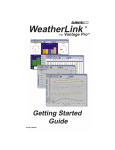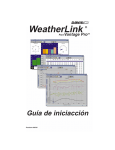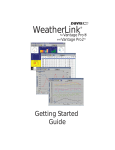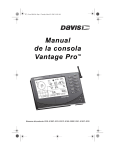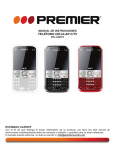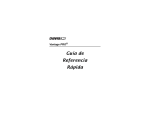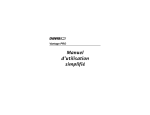Download DAVIS WeatherLink Troubleshooting guide
Transcript
WeatherLink ® For Windows ® For Vantage Pro®, Weather Monitor II®, Weather Wizard III® and Perception II® Weather Stations Getting Started Guide Product # 6510C & 7862 FCC Part 15 Class B Registration Warning This equipment has been tested and found to comply with the limits for a Class B digital device, pursuant to Part 15 of the FCC Rules. These limits are designed to provide reasonable protection against harmful interference in a residential installation. This equipment generates, uses and can radiate radio frequency energy and, if not installed and used in accordance with the instructions, may cause harmful interference to radio communications. However, there is no guarantee that interference will not occur in a particular installation. If this equipment does cause harmful interference to radio or television reception, which can be determined by turning the equipment on and off, the user is encouraged to try to correct the interference by one or more of the following measures: •Reorient or relocate the receiving antenna •Increase the separation between the equipment and receiver •Connect the equipment into an outlet on a circuit different from that to which the receiver is connected •Consult the dealer or an experienced radio/TV technician for help. Changes or modifications not expressly approved in writing by Davis Instruments may void the user’s authority to operate this equipment. Product Number: 6510C, 7862 Davis Instruments Part Number: 7395.179 WeatherLink ® for Windows Getting Started Guide Rev. A (June 18, 2003) © Davis Instruments Corp. 2003. All rights reserved. Cover photo by Ronald Ross. Vantage Pro, WeatherLink, Weather Monitor II, and Weather Wizard III are registered trademarks of Davis Instruments Corp. Hayes is a registered trademark of Hayes Microcomputer Products, Inc. Windows is a trademark of Microsoft Corporation. WL Windows GSG content D009.fm Page 1 Friday, September 12, 2003 12:29 PM WELCOME TO WEATHERLINK! Welcome to Weathe rLink! Welcome to Davis Instruments’ WeatherLink for Windows. WeatherLink’s data logger and software connects a personal computer to your Davis weather station, allowing you to store, view, plot, analyze, export, and print your weather data. The following Davis Instruments’ weather stations are supported: Vantage Pro®, Vantage Pro Plus, Weather Monitor II®, Weather Wizard III®, and Perception II®. Co n t en ts of P ack ag e Before continuing, please make sure your WeatherLink package contains the following listed items: WeatherLink for Vantage Pro (#6510C) ▲ Data Logger for Vantage Pro ▲ 8’ (2.4 m) cable with connector to link your station to your computer. ▲ 9-pin (DB-9) PC COM Port Adapter (blue) Use the 9-pin adapter to connect the data logger to a 9-pin serial port. Note: If you need a 25-pin adapter, contact Davis Instruments Technical Support at 510732-7814. ▲ Loopback connector The loopback connector is a short piece of cable with a phone plug at one end and a red plastic cap at the other. ▲ WeatherLink Software CD ROM WeatherLink for Monitor, Wizard and Perception (#7862) ▲ Data Logger for Monitor, Wizard and Perception ▲ 9-pin (DB-9) PC COM Port Adapter (black) Use the 9-pin adapter to connect the data logger to a 9-pin serial port. Note: If you need a 25-pin adapter, contact Davis Instruments Technical Support at 510732-7814. ▲ Loopback connector The loopback connector is a short piece of cable with a phone plug at one end and a red plastic cap at the other. ▲ WeatherLink Software CD ROM 1 WL Windows GSG content D009.fm Page 2 Friday, September 12, 2003 12:29 PM OPTIONAL ACCESSORIES Hardware Requirements O p ti on a l A cc es so rie s The following optional accessories, designed for use with WeatherLink, are available from your dealer or may be ordered directly from Davis. ▲ Telephone Modem Adapter For transmission of data from the data logger using a modem. ▲ Standard 4-Conductor Extension Cable For more flexibility in the placement of your console. Add one 40’ (12 m) extension cable to extend the distance between your station and the computer. (48’ (14.4 m) maximum) H a r d w a r e I n s ta l l at i o n You can either install WeatherLink to use a direct, local connection between your computer and weather station, or you can install WeatherLink to use a modem connection to a remote weather station. Requirements and installation for each type of connection differ, and are explained separately below. Ha r d wa re R e qui re me nts The required hardware differs depending on whether you are making a local connection or a remote modem connection. Local Connection Hardware Requirements The following additional hardware is required for a local connection: ▲ Computer running Windows™ 95, 98, ME, NT 4.0, 2000, or XP with at least 5 MB of free disk space The amount of disk space necessary depends on the archive interval. Database files containing data stored at a 30 minute archive interval require approximately 132K of disk space per month of data. The file size changes in a linear fashion depending on the archive interval. For example, data stored at a 1– minute interval requires approximately 3.9 MB per month while the data stored at a 2–hour interval requires approximately 33 KB per month. ▲ Windows-Compatible Display VGA minimum. SVGA or High (16-bit) Color recommended. ▲ One Free Serial Port Remote Modem Connection Hardware Requirements In addition to the provided hardware and the computer equipment listed above, the following hardware is required for a remote modem connection. • One external modem to connect to the data logger at the remote site. • One internal or external modem connected to your computer • Modems must be Hayes®–compatible and able to send data at 1200, 2400, 4800, 9600, or 19200 baud for use with Vantage Pro stations or at 1200 or 2400 baud for use with a Monitor II, Wizard III, or Perception II weather station. 2 WL Windows GSG content D009.fm Page 3 Friday, September 12, 2003 12:29 PM LOCAL CONNECTION FOR VANTAGE PRO Hardware Requirements ▲ Telephone Modem Adapter The Telephone Modem Adapter is specially wired to provide the connection between the data logger and the modem. • Use a #6533 adapter with Vantage Pro Stations. • Use a #7870 adapter with Wizard III, Monitor II, and Perception stations. A Few Notes About Remote Modem Connections If you use a remote modem connection, WeatherLink will automatically dial the station whenever you initiate a program action that requires the software to talk to the station. Toolbar with On-Line Icon While connected to a remote station, an “On-Line” icon appears in the toolbar. This icon indicates that you are on-line and may be used to hang up a remote connection. To hang up, choose the On-Line icon from the toolbar or choose Hang Up from the File menu. By default, WeatherLink will hang up the connection to the modem after one minute without any communication with the station. Use the Serial Port dialog box in the Setup menu of WeatherLink to change this default value. (See the WeatherLink help files for more on this subject.) Note: WeatherLink will not hang up the phone line if the bulletin, summary, or other windows receiving real-time data from the console are active. L oc al Co n n ec ti on fo r Va n tag e P r o The instructions below explain how to make a typical local connection between your Vantage Pro station and your computer. Note: If you extend the cable run beyond 48’ (14.4 m), the software may have difficulty communicating with the station. 1. Enter the console’s Setup Mode by pressing and holding the DONE key, then pressing the “DOWN arrow” key. Entering Setup Mode ensures that the station is not writing any data and saves the current daily totals, highs, and lows to memory. 3 WL Windows GSG content D009.fm Page 4 Friday, September 12, 2003 12:29 PM LOCAL CONNECTION FOR VANTAGE PRO Hardware Requirements 2. Remove the battery cover from the console back and remove all power by removing the batteries and AC-power adapter, if present. Failure to remove power to the console before installing the data logger may cause damage to the data logger or console. Vantage Pro console COM Ports (DB-9) 9-pin connector data logger battery cover 8' (2.5 m) data logger cable Optional 40' (12 m) 4-Conductor Extension Cable and Coupler Connection Options Connecting your Computer Directly to your Weather Station 3. Carefully insert the data logger into the large receptacle jack marked EXPANSION inside the battery compartment Guide the data logger cable through the square slot below the receptacle. CAUTION: Make sure that whenever you connect or disconnect the logger from the console that the console is NOT powered up. Plugging or unplugging the data logger while power is applied can lock up or damage the logger. 4. Restore power to the weather station by reinstalling the batteries and reattaching the power adapter, if present. The weather station should beep three times; each beep should occur within about one second of the others. 5. Replace the battery cover, ensuring that the data logger cable exits through the square slot. 6. Locate a free serial port on the back of your computer and connect the blue DB9 to the port. 7. Insert the cable plug at the end of the short cable coming from the data logger into the receptacle on the end of the 8’ cable. Then insert the cable plug on the end of the 8’ cable into the DB9 adapter. The cable connecting the data logger to the computer is 8’ (2.4 m) long. If you need to place the station console more than 8’ from the computer, use a 40’ (12 m) standard 4-conductor extension cable. Do not attempt to use more than 40’ of extension cable, or the data logger may have difficulty communicating with the computer. 4 WL Windows GSG content D009.fm Page 5 Friday, September 12, 2003 12:29 PM REMOTE CONNECTION FOR VANTAGE PRO Hardware Requirements Note: You do not need to keep the console connected to the computer for the logging to work. You can connect the cable to the computer when you’re ready to download, then disconnect it if you want to place the console somewhere else. However, you can only run WeatherLink’s bulletin, summary, or other real-time windows if the console is attached to the computer. 8. Check the Baud rate settings on the console. Enter the console SETUP mode by pressing and holding the DONE key, then pressing the DOWN arrow key. Use the BAR and DONE keys to scroll to the Baud Rate screen. The Baud Rate setting here on the console must be same as that set in the WeatherLink software. Use the UP and DOWN arrow keys to change the baud rate setting, if needed. Press and hold DONE to return the console to current weather mode. Re m ot e Co n n ec ti on f o r Va n tag e P r o Use a remote modem installation to connect your computer to a remote Vantage Pro station. A remote modem installation involves connecting the data logger to the weather station and to a modem at the station console site and connecting your computer’s modem to a phone line, which will allow you to dial the weather station. Note: Before installing the console and modem at a remote location, test the data logger and connection first using a direct connection like that shown in the section above. Remote Modem Installation Instructions 1. Install and set up an internal or external modem (according to the instructions supplied by the manufacturer) for use with your computer. Make a note of the COM port used by the modem. You will need this information when entering serial port settings for the station. Vantage Pro console data logger battery cover 8' (2.5 m) data logger cable 5 WL Windows GSG content D009.fm Page 6 Friday, September 12, 2003 12:29 PM REMOTE CONNECTION FOR VANTAGE PRO Hardware Requirements 2. At the station console site, put the external modem in a location where it can connect to both the logger and a phone jack and plug it into the phone jack. IMPORTANT: DO NOT TURN THE MODEM ON AT THIS TIME. The cable connecting the data logger to the modem is 8’ (2.4 m) long. If you need to mount the station console more than 8’ from the modem, use a 40’ (12 m) standard 4-conductor extension cable. Do not attempt to use more than 40’ of extension cable, or the data logger may have difficulty communicating with the modem. 3. Plug the external modem into the phone jack. 4. Place the console in setup mode. Press and hold the DONE key, then press the DOWN arrow key. Entering Setup Mode ensures the station is not writing any data to memory and saves all current highs, lows, and daily totals. 5. Remove the battery cover from the console back and remove all power by removing the batteries and AC-power adapter, if present. Failure to remove power to the console before installing the data logger may cause damage to the data logger or console. 6. Carefully insert the data logger into the large receptacle jack marked EXPANSION inside the battery compartment Guide the data logger cable through the square slot below the data logger receptacle. CAUTION: Make sure that whenever you connect or disconnect the data logger from the console that the console is NOT powered up. Plugging or unplugging the data logger while power is applied can damage or lock up the data logger. 7. Connect the blue Telephone Modem Adapter to the external modem. Do not use a DB25 (not included) adapter and a gender changer to attach the logger to a modem because it will not work. Do not use a black Davis telephone modem adapter, either, as it will not work with the Vantage Pro. 8. Insert the cable plug at the end of the cable into the Telephone Modem Adapter. 9. Restore power to the weather station by reinstalling the batteries and reattaching the power adapter, if present. The weather station should beep three times; each beep should occur within about one second of the others. 10. Replace the battery cover, ensuring that the data logger cable exits through the square slot. 11. Turn the modem ON. Turning the modem on at this point allows it to receive the modem initialization string from the console. 12. Set the baud rate on the Vantage Pro console. Enter Setup on the console by pressing and holding the DONE key, then pressing the DOWN arrow key. Use the BAR and DONE keys to scroll through the setup screens until you reach the BAUD RATE setup screen. CAUTION: The Baud Rate setup screen will only appear if you have installed the data logger. 6 WL Windows GSG content D009.fm Page 7 Friday, September 12, 2003 12:29 PM LOCAL CONNECTION FOR MONITOR, WIZARD AND PERCEPTION Hardware Requirements ▲ Use the up and down arrows to set the desired baud rate. Use the fastest baud rate your modem can handle. 19200 is the fastest baud rate available and is the default setting on the console. ▲ Press DONE when you’ve got the correct baud rate on the console screen. Pressing DONE in this screen sends the initialization string to the modem, so you don’t have to turn the console on and off again. L oc al Co n n ect io n f o r M o n it o r, Wiz a r d an d P e r ce p ti on The instructions below explain how to connect your Weather Monitor II, Weather Wizard III, or Perception II weather station directly to your computer. Note: If you extend the cable run beyond 48’ (14.4 m), the software may have difficulty communicating with the station. Typical Local Connect for Original Weather Stations 1. Make a note of the barometric pressure, total rainfall, and (if applicable) calibration numbers. You must remove power from the weather station console to install the data logger. Removing power will cause these stored weather values to be erased. Use WeatherLink to reenter these values after restoring power to the console. 2. Remove the mounting base from the console. 3. Remove all power from the console by removing the power adapter and battery backup. Failure to remove power before installing the data logger may cause damage to the data logger and/or console. 4. A small switch near the data logger cables controls the baud rate. The default setting is 2400 baud. If you need to run at 1200 baud, change the setting before connecting the data logger to the console. 7 WL Windows GSG content D009.fm Page 8 Friday, September 12, 2003 12:29 PM REMOTE CONNECTION FOR MONITOR, WIZARD AND PERCEPTION Hardware Requirements 5. Connect the short data logger cable to the cable jack marked “WeatherLink” on the bottom of your weather station console. 6. Restore power to the console by reattaching the power adapter and battery backup. The console should beep three times. The third beep, which should occur within 30 seconds, indicates that the data logger is operating correctly. 7. Place the data logger inside the mounting base. Placing Data Logger Inside Base 8. Reattach the mounting base to the weather station. As you do so, guide all the cables through the slots on the mounting base. 9. Locate a free serial port on the back of your computer and connect the black DB9 adapter to the port. 10. Connect the long data logger cable to the DB9 adapter connector. The cable connecting the data logger to the computer is 8’ (2.4 m) long. If you need to place the station console more than 8’ from the computer, use a 40’ (12 m) standard 4-conductor extension cable. Do not attempt to use more than 40’ of extension cable, or the data logger may have difficulty communicating with the computer. Re m ot e Co n n ect i on f o r M o ni to r, Wiz ar d an d P e r ce p ti on You can connect your computer to a remote weather station using a modem. This involves using the data logger to connect the weather station console to a modem at the remote site. Your computer can then use a modem to communicate to the remote weather station via a phone line. At Your Computer: 1. If you don’t have a modem, install and set up an internal or external modem according to the instructions supplied by the manufacturer. 2. Connect the modem to the phone line. 8 WL Windows GSG content D009.fm Page 9 Friday, September 12, 2003 12:29 PM REMOTE CONNECTION FOR MONITOR, WIZARD AND PERCEPTION Hardware Requirements At Your Weather Station Console: 3. Make a note of the barometric pressure, total rainfall, and (if applicable) calibration numbers. You must remove power from the weather station to install the WeatherLink data logger, which will cause these values to be erased. Use WeatherLink to reenter these values after restoring power to the station. 4. Place the external modem in a location where it can connect to both the data logger and the phone jack. Do not turn the modem on at this time. 5. Remove the mounting base from the weather station. 6. Remove all power from the weather station by removing the power adapter and battery backup. Failure to remove power before installing the data logger may cause damage to the data logger and/or station. Typical Remote Installation for Original Weather Stations 7. A small switch on the data logger near the cables controls the baud rate. The default setting is 2400 baud. If you need to run at 1200 baud, change the setting before connecting the data logger to the console. 8. Connect the short data logger cable to the cable jack marked “WeatherLink” on the bottom of your weather station console. 9. Connect the blue Telephone Modem Adapter to the external modem. The Telephone Modem Adapter (#7870) is required to use the data logger with a modem. A standard DB25 connector with a gender changer will not work. The blue Telephone Modem Adapter (#6533) supplied for Vantage Pro stations will not work either. 10. Connect the long data logger cable to the Telephone Modem Adapter. 11. Turn the modem on. 9 WL Windows GSG content D009.fm Page 10 Friday, September 12, 2003 12:29 PM SOFTWARE INSTALLATION AND SETUP Installing the Software Note: It is very important to follow the order of these instructions. The modem must be connected and turned on before you apply power to the weather station console. 12. Restore power to the weather station console by reattaching the power adapter and battery backup. The weather station should beep three times. The third beep, which should occur within 30 seconds, indicates that the WeatherLink is operating correctly. 13. Place the data logger inside the mounting base. 14. Reattach the mounting base to the weather station. As you do so, guide all the cables through the slots on the mounting base. Placing Data Logger Inside Base S o ftw a r e In sta ll at io n an d S et up It is easy to install and setup WeatherLink on your computer. Ins tal li ng t h e S o ft w a r e 1. Place the Install Disk in your CD ROM drive. 2. The install program should start automatically. If the install program does not start, choose Run from the Start menu, type D:\SETUP (or E:\SETUP, substituting the correct drive letter for D or E), and choose OK to begin the installation. 3. Follow the on-screen prompts to complete the installation. Run nin g th e S oft war e To run the software, double-click on the WeatherLink icon. If you have no stations in the program directory when you run the software, the software will prompt you to add a station (see below for details). If you have more than one station in the program directory when you run the software, the software will automatically open the last station that was opened. Note: To get the most use out of your WeatherLink software, please refer to the WeatherLink Help. 10 WL Windows GSG content D009.fm Page 11 Friday, September 12, 2003 12:29 PM SOFTWARE INSTALLATION AND SETUP Station Setup Sta t ion S e t up To interact with your station, you must add your station to WeatherLink’s database, which means naming the station, configuring the software to work with that station and with your computer hardware, and setting station values such as time, barometric pressure, total rainfall, and calibration numbers. Adding a Station 1. Choose New Station from the File menu. The software opens the Add New Station dialog box. 2. Type the station name into the text box. The station name may be up to 40 characters/spaces long. Note that the software uses the first eight characters of the station name (not counting spaces or punctuation marks) as the name of the directory into which it saves this station’s database and configuration files. The first eight characters of each station name must, therefore, be unique. 3. Choose OK. The software saves the station, creates a directory and subdirectories for that station, and prompts you to indicate whether you want to enter the walkthrough procedure. About the Walkthrough The software includes a station setup walkthrough that steps you through the station configuration procedure. After adding a new station, the software automatically asks you whether or not you want to be walked through the configuration procedure. You can, of course, choose No and set up the station by choosing all of the necessary commands from the menus. A Walkthrough command is included in the Setup menu that lets you enter this procedure at any time. Note: When necessary, the software will automatically dial a phone modem station. If you choose Yes to begin the walkthrough, the software takes you through the the setup process, one dialog box at a time. The walkthrough may vary depending on your station’s configuration. At each step in the walkthrough procedure, the software will provide confirmation boxes prompting you to indicate whether or not you wish to continue. To continue, choose OK. To skip any step and move to the next, choose Skip. To cancel the entire walkthrough procedure, choose Cancel. Fin din g t h e Cor r e ct S er i al P or t The software includes a procedure for locating the serial port to which your station is connected or determining whether that serial port is working. Using the Loopback command (as opposed to Test) will help you find the correct port and determine whether the serial port or the data logger is causing a communication problem. The loopback function will also detect and report the presence of any modems. To use this procedure, you will need the loopback connector (the short cable with a phone jack on one end and a red plastic tip on the other) supplied with Weatherlink. 11 WL Windows GSG content D009.fm Page 12 Friday, September 12, 2003 12:29 PM UPDATING PREVIOUS VERSIONS Database Conversion 1. If necessary, disconnect the cable between your station and the adapter connected to the COM port. 2. Insert the loopback connector into the adapter. 3. In WeatherLink, click on Serial Port in the Setup menu. The software opens the Serial Port dialog box. Loopback connector 4. Click Loopback. The software will search all standard serial ports and inform you of the COM port at which the loopback connector is located. The software automatically selects the correct COM port for you in the Serial Port dialog box. If it cannot find the loopback connector at any COM port, your serial port may not be working. Consult your computer documentation for help. Upd a ti ng P r ev io u s Ve r si o ns WeatherLink versions 5.2 and later use a different record structure for storing data. This change makes WeatherLink 5.2 and later versions incompatible with the data files from earlier releases. The following procedures explain how to convert older WeatherLink data files (WeatherLink 3.x, 4.x, 5.0 and 5.1) for use with WeatherLink 5.2 and later. If you are updating from version 5.0 or 5.1, there are also instructions on how to retrieve additional existing data from your Vantage Pro data logger and incorporate it with your weather data files. Da taba s e Co nve r si on If you have an existing weather database from WeatherLink 5.1 or earlier (including versions of WeatherLink 3.x and 4.x), there are two ways you can convert those files for use by WeatherLink 5.2+. Con ve r t a Wea t he r Li nk Sta t ion This method converts all the data files in an existing WeatherLink station directory and retains the previously entered station configuration data. 1. Install the new version of WeatherLink in a new program folder. 1. Copy the station folder from your previous WeatherLink program folder to your WeatherLink 5.2+ program folder. 2. Use the WeatherLink Open Station command in the File Menu to open the copied station folder. 3. WeatherLink automatically detects that the station was created by a previous version of the software and asks if you want to convert the data and station. Choose OK to convert the station configuration, including the weather data files. WeatherLink automatically creates a backup copy of the old files and then converts them for use by WeatherLink 5.2+. 12 WL Windows GSG content D009.fm Page 13 Friday, September 12, 2003 12:29 PM UPDATING PREVIOUS VERSIONS Import Data Files Im por t D ata F il es This method allows you to select individual files or groups of files to be converted for use by WeatherLink 5.2+. 1. Open WeatherLink 5.2+ and choose Import Database Files from the File menu. 2. Select the data files you want to import. 3. 4. 5. You can select one file or multiple files in the same folder. Choose OPEN to have the selected files converted. They will be put into a subdirectory called "Converted Database Files". Copy the converted files to your station directory. You will need to reopen your station in WeatherLink before you will be able to see the converted data files. Re tr ie vi ng 5 .0 a nd 5. 1 Da ta Fr om the D a ta L ogge r The archive memory in your Vantage Pro WeatherLink data logger contains data not used by WeatherLink 5.0 or 5.1, such as UV, solar radiation, rain rate, and ET. Depending on your archive interval, you may have up to 200 days of this data in your logger. To incorporate this data into your WeatherLink 5.2+ data files: 1. Choose New Station in the File menu to create a temporary weather station folder. 2. Choose Download in the File menu or click on the download icon. 3. 4. 5. 6. 7. 8. WeatherLink will do a full download of all data stored in the data logger. Choose Browse in the Window menu or click on the Browse icon. Scroll to the beginning of the data file, and write down the time and date of the first entry in the database. Open your original WeatherLink station using the Open Station command in the File menu. Choose Browse in the Window menu or click on the Browse icon. Choose Delete Records in the Browse Menu Select the records for all the days following the earliest date in your temporary station database. Note:Do not select the records for the day on which your temporary database begins. We will individually delete the records for that day in the next step. 9. In the Browse Window, you will need to individually select and delete each record in the data base that is dated after the earliest record in your temporary database. Note:WeatherLink only downloads data for dates and times not already in the database. Deleting records allows it to download new data. 10. Choose Download in the File menu or click on the Download icon to download data from the data logger. You should now have records in your data base up to the current time that include all the new information that has been stored in your data logger. 11. Delete the temporary station you created in Step 1. 13 WL Windows GSG content D009.fm Page 14 Friday, September 12, 2003 12:29 PM TROUBLESHOOTING GUIDE Recalculate THSW Index - Vantage Pro Only Re c al cu la t e TH SW In dex - Va nta ge P r o O nly WeatherLink 5.3 and later supports a new derived data parameter, the Temperature Humidity Sun Wind (THSW) Index. If you have a solar radiation sensor, you can have this value calculated for existing data by selecting the “Recalculate THSW Index” command in the Browse Menu, which is displayed when the Browse window is open. Note: Be sure to verify that the latitude and longitude settings and daylight savings time settings are correct before using this command. Tro u b les h oo t in g G u id e The following section answers some of the most commonly asked questions about WeatherLink®. Please consult this guide and WeatherLink Help before contacting Technical Support (see page 17). Com mun ic at i ons Pr ob le ms ? Why can’t the WeatherLink software communicate with the data logger and station? If you are having trouble establishing communication between the weather station and WeatherLink, start by checking the weather station’s own diagnostics. Remove all power to the weather station and then restart it by restoring power (with the data logger still attached). Note: Vantage Pro Only - The data logger uses non-volatile memory, so you won’t lose any data you’ve already recorded. However, make sure to put the console in Setup Mode by pressing and holding the [DONE] key, then pressing the [-] key before removing the batteries. This ensures the station will not try to write any data as the power goes off. • You should hear three beeps, each of which occurs when the weather station passes one of its diagnostic tests. Each beep follows the previous after about one second. The first beep tells you the processor is running. The second beep will be for the logger (if installed) and the third beep is for the display. If you do not hear one or more of these beeps, contact Davis Instruments at 510-732-7814. (You’ll only hear two beeps if you don’t have the data logger installed.) • If you hear all three beeps, See “Finding the Correct Serial Port” on page 11 for instructions on checking your standard serial ports. If this identifies a serial port other than the one you selected in station setup, try connecting to the data logger again. • Vantage Pro Only - make sure you are using the blue serial port adapter supplied with WeatherLink #6510C. The black Davis serial adapters will not work. • If you have a Monitor, Wizard or Perception station, make sure you are using the black serial port adapter supplied with WeatherLink #7862. The blue Davis serial adapters will not work. 14 WL Windows GSG content D009.fm Page 15 Friday, September 12, 2003 12:29 PM TROUBLESHOOTING GUIDE Program Problems • Check the Baud Rate setting on the console and in the serial port dialog box in the software. Make sure they’re set to the same number. Note: Enter the console’s Setup Mode by pressing and holding the DONE key, then pressing the DOWN arrow key on the console. Scroll through the setup choices by pressing the BAR or DONE keys until you reach the Baud Rate screen. This screen only appears if the data logger is plugged into the console. • Vantage Pro Only - Enter the console’s Setup Mode by pressing and holding the [DONE] key, then pressing the [-] key on the console. Scroll through the setup choices by pressing the [BAR] or [DONE] keys until you reach the Baud Rate screen. This screen only appears if the data logger is plugged into the console. • Monitor, Wizard and Perception Only - Check the switch setting on the data logger. It will be set to either 1200 or 2400 Baud. If you still cannot connect or if the loopback test identifies the serial port you already have selected, eliminate the following possibilities. If you have questions on how to proceed, contact your PC vendor or PC technical support. ▲ You have a hardware device conflict. Check the device manager tab in the Windows® system properties dialog box to ensure that Windows recognizes your COM port. Consult your pc’s documentation to see how to access the system properties dialog box. ▲ Your serial port uses a non-standard device name. WeatherLink recognizes serial ports named COM1 through COM10 only. To use a modem, you must specify the underlying COM port on your PC. To find out which port the modem’s connected to, you can look in Windows’ System Properties > Device Manager > “modem name” Properties > Modem > Port, where “modem name” is the name of the modem you have installed. ▲ Your serial port is defective. ▲ The loopback connector or the WeatherLink adapter plug is bad. P ro gr am P r o b l em s ? The barometer graph on the Bulletin does not “fill in” completely. When you first load the bulletin, the barometer graph will only fill in completely when you have data in your database for the last six hours. Make sure of the following: ▲ There is data in your database for the span of the barometer graph. ▲ The time and date of the stored barometer data is correct in your database. ▲ The time and date on the PC is correct. ▲ The time and date on the weather station are correct. 15 WL Windows GSG content D009.fm Page 16 Friday, September 12, 2003 12:29 PM TROUBLESHOOTING GUIDE Program Problems ? No wind direction reading (or dashes instead of a reading) appears in my database. Be aware that if there is no wind speed when the direction is being sampled, wind direction is not recorded. During intervals with no wind speed, no direction will be recorded. CAUTION: Since high wind speed is sampled more often, it is possible to have a high wind speed but no wind speed. ? Vantage Pro Only: WeatherLink says “No new data to download” but I know there’s data there. What can I do? Vantage is smart enough to send only data it hasn’t already sent to the computer. So, when you initiate a new download, the program will retrieve the first record after the last record shown in the WeatherLink’s Browse Window. Older data is stored in the logger as a backup. To see how many of these backup records are stored in the logger, create a new station and download the data into this new database. Because there are no records stored in the station you just created, WeatherLink will download everything it has stored. Next, try clearing the archive memory using the clear dialog box. You will lose any data not already downloaded in your archive memory, but all of your calibration numbers and alarm settings will remain intact. If this doesn’t work, reboot your weather station (that is, remove, then restore all power to the station). CAUTION: Make sure to put the console in Setup Mode (by pressing the DONE and DOWN arrow keys) before removing the batteries. The ensures the station will not try to write any data when the power goes off. 16 ? Monitor, Wizard and Perception Only: My archive memory is empty and I know it should not be. What can I do? First try using the “Set Archive Interval” command in the Setup menu to clear the archive memory and see if this corrects the problem. You will lose any undownloaded data in your archive memory, but all your calibration numbers and alarm settings will remain intact. If this doesn’t work, restart your weather station by removing the AC power adapter and the backup battery and then reconnecting them. All data which has not been downloaded will be lost. You will also have to reset all console settings such as the barometer, calibration numbers, and alarm settings. ? Monitor, Wizard and Perception Only: After successfully downloading, the data does not appear in my database. Where is it? The most likely possibility in this case is that the time and date on your weather station are incorrect. This usually happens if there is a power outage and you don’t reset the time and date afterwards. In this case the data was written into the wrong time and month. Correctly set the time and date on your weather station and all future data should download correctly. It is also possible, if you have multiple stations, that you downloaded data into the wrong station’s database. Make sure the desired station is open before downloading. WL Windows GSG content D009.fm Page 17 Friday, September 12, 2003 12:29 PM TROUBLESHOOTING GUIDE Contacting Davis Technical Support ? When viewing data, dashes appear in place of a value for functions other than wind direction. Why? If no data was recorded by a sensor (for example, the sensor was disconnected or radio interference blocked reception) or if bad data was recorded for a sensor (for example, the sensor was malfunctioning), the software dashes out the entry rather than showing invalid data. You can use the record editor to correct these entries. ? The data I want to see, such as humidity (Monitor), or solar radiation, soil moisture, or Temp 2 (Vantage Pro) is missing completely or is greyed-out? All optional sensors must be enabled in the Station Configuration setup dialog box before the data will be displayed in WeatherLink. If you are not seeing data from a sensor that is installed in your weather station, be sure check the Station Configuration in the Setup Menu and make sure the sensor has been selected. Con ta c ting D av is Tec hni ca l Supp or t If you have questions about WeatherLink software, or encounter problems installing or operating the software, please contact Davis Technical Support. Most questions can be answered while you are on the phone. Note: Sorry, we are unable to accept collect calls. (510) 732-7814 – Monday – Friday, 7:00 a.m. – 5:30 p.m. Pacific Time (510) 670-0589 – Fax Technical Support [email protected] – E-mail to Technical Support [email protected] – E-mail to Davis Instruments. www.davisnet.com – Copies of User Manuals are available on the “Support” page. Watch for FAQs and other updates. Subscribe to the e-newsletter. 17 WL Windows GSG bcover final.fm Page 17 Tuesday, April 15, 2003 9:19 AM Toolbar Icons Open Station Bulletin Window Download Plot Window Strip Chart Window Yearly Rainfall Database Window Alarm Indication On-Line (Hang Up) This MonthÕs NOAA Summary View Help Print Window Exit Program Hot Keys Main Program Window Strip Chart Window Ctrl-A . . . . . . Set Alarms ESC . . . . . . . Halt redraw Ctrl-B . . . . . . View Bulletin Ctrl-M . . . . . Make Default Ctrl-C . . . . . . Station Configuration Ctrl-P . . . . . . Print Strip Chart Ctrl-G . . . . . . Degree-Days Report F1 . . . . . . . . . Context-Sensitive Help Ctrl-H . . . . . . Hang Up F3 . . . . . . . . . Zoom In Ctrl-I . . . . . . . Serial Port Settings F4 . . . . . . . . . Zoom Out Ctrl-J . . . . . . Automatic Download Ctrl-K . . . . . . Walkthrough Ctrl-L . . . . . . Download Ctrl-O . . . . . . Open Station Ctrl-P . . . . . . Print Active Window Ctrl-Q . . . . . . Open Plot Window Ctrl-R . . . . . . Yearly Rain Report Ctrl-S . . . . . . Open Strip Charts Ctrl-T . . . . . . Set Time Ctrl-U . . . . . . Select Units Plot Window ESC . . . . . . . Halt redraw Ctrl-D. . . . . . Choose Date Ctrl-M . . . . . Make Default Ctrl-P . . . . . . Print Plot F1 . . . . . . . . . Context-Sensitive Help F3 . . . . . . . . . Zoom In F4 . . . . . . . . . Zoom Out F9 . . . . . . . . . Overlay Plots F10 . . . . . . . . Last Year Plot Ctrl-V . . . . . . View Download Log Ctrl-W . . . . . Browse Database Ctrl-X . . . . . . Auto Fax Settings Ctrl-Y . . . . . . View Summary Ctrl-Z . . . . . . Close Window F1 . . . . . . . . . Context-Sensitive Help F2 . . . . . . . . . Sunrise/Sunset Report F7 . . . . . . . . . NOAA This Month F8 . . . . . . . . . NOAA This Year Database Window Ctrl-D. . . . . . Choose Date Ctrl-N. . . . . . Add Note Ctrl-P . . . . . . Print Records Enter . . . . . . Edit Record Delete . . . . . Delete Record F1 . . . . . . . . . Context-Sensitive Help Yearly Rainfall Window Enter . . . . . . Edit Year Delete . . . . . Delete Year 3465 Diablo Avenue, Hayward, CA 94545-2778 U.S.A. 510-732-9229 • Fax: 510-732-9188 E-mail: [email protected] • www.davisnet.com




















